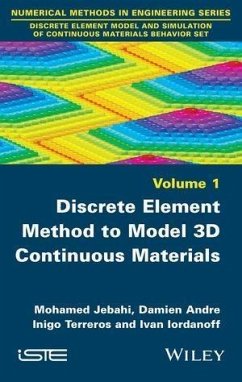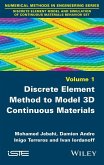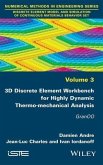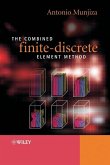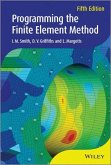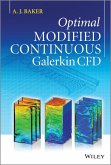Discrete Element Method to Model 3D Continuous Materials (eBook, PDF)


Alle Infos zum eBook verschenken

Discrete Element Method to Model 3D Continuous Materials (eBook, PDF)
- Format: PDF
- Merkliste
- Auf die Merkliste
- Bewerten Bewerten
- Teilen
- Produkt teilen
- Produkterinnerung
- Produkterinnerung

Hier können Sie sich einloggen

Bitte loggen Sie sich zunächst in Ihr Kundenkonto ein oder registrieren Sie sich bei bücher.de, um das eBook-Abo tolino select nutzen zu können.
Complex behavior models (plasticity, cracks, visco elascticity) face some theoretical difficulties for the determination of the behavior law at the continuous scale. When homogenization fails to give the right behavior law, a solution is to simulate the material at a meso scale in order to simulate directly a set of discrete properties that are responsible of the macroscopic behavior. The discrete element model has been developed for granular material. The proposed set shows how this method is capable to solve the problem of complex behavior that are linked to discrete meso scale effects.
- Geräte: PC
- mit Kopierschutz
- eBook Hilfe
- Größe: 6.42MB
![Discrete Element Method to Model 3D Continuous Materials (eBook, ePUB) Discrete Element Method to Model 3D Continuous Materials (eBook, ePUB)]() Mohamed JebahiDiscrete Element Method to Model 3D Continuous Materials (eBook, ePUB)139,99 €
Mohamed JebahiDiscrete Element Method to Model 3D Continuous Materials (eBook, ePUB)139,99 €![3D Discrete Element Workbench for Highly Dynamic Thermo-mechanical Analysis (eBook, PDF) 3D Discrete Element Workbench for Highly Dynamic Thermo-mechanical Analysis (eBook, PDF)]() Damien Andre3D Discrete Element Workbench for Highly Dynamic Thermo-mechanical Analysis (eBook, PDF)139,99 €
Damien Andre3D Discrete Element Workbench for Highly Dynamic Thermo-mechanical Analysis (eBook, PDF)139,99 €![Discrete-continuum Coupling Method to Simulate Highly Dynamic Multi-scale Problems (eBook, PDF) Discrete-continuum Coupling Method to Simulate Highly Dynamic Multi-scale Problems (eBook, PDF)]() Mohamed JebahiDiscrete-continuum Coupling Method to Simulate Highly Dynamic Multi-scale Problems (eBook, PDF)139,99 €
Mohamed JebahiDiscrete-continuum Coupling Method to Simulate Highly Dynamic Multi-scale Problems (eBook, PDF)139,99 €![The Combined Finite-Discrete Element Method (eBook, PDF) The Combined Finite-Discrete Element Method (eBook, PDF)]() Antonio A. MunjizaThe Combined Finite-Discrete Element Method (eBook, PDF)177,99 €
Antonio A. MunjizaThe Combined Finite-Discrete Element Method (eBook, PDF)177,99 €![Introduction to Finite Element Analysis (eBook, PDF) Introduction to Finite Element Analysis (eBook, PDF)]() Barna SzabóIntroduction to Finite Element Analysis (eBook, PDF)89,99 €
Barna SzabóIntroduction to Finite Element Analysis (eBook, PDF)89,99 €![Programming the Finite Element Method (eBook, PDF) Programming the Finite Element Method (eBook, PDF)]() I. M. SmithProgramming the Finite Element Method (eBook, PDF)94,99 €
I. M. SmithProgramming the Finite Element Method (eBook, PDF)94,99 €![Optimal Modified Continuous Galerkin CFD (eBook, PDF) Optimal Modified Continuous Galerkin CFD (eBook, PDF)]() A. BakerOptimal Modified Continuous Galerkin CFD (eBook, PDF)121,99 €
A. BakerOptimal Modified Continuous Galerkin CFD (eBook, PDF)121,99 €-
-
-
Dieser Download kann aus rechtlichen Gründen nur mit Rechnungsadresse in A, B, BG, CY, CZ, D, DK, EW, E, FIN, F, GR, HR, H, IRL, I, LT, L, LR, M, NL, PL, P, R, S, SLO, SK ausgeliefert werden.
- Produktdetails
- Verlag: John Wiley & Sons
- Seitenzahl: 196
- Erscheinungstermin: 26. Februar 2015
- Englisch
- ISBN-13: 9781119102915
- Artikelnr.: 42492270
- Verlag: John Wiley & Sons
- Seitenzahl: 196
- Erscheinungstermin: 26. Februar 2015
- Englisch
- ISBN-13: 9781119102915
- Artikelnr.: 42492270
- Herstellerkennzeichnung Die Herstellerinformationen sind derzeit nicht verfügbar.
LIST OF TABLES xv
PREFACE xvii
INTRODUCTION xxi
CHAPTER 1. STATE OF THE ART: DISCRETE ELEMENT MODELING 1
1.1. Introduction 1
1.2. Classification of discrete methods 3
1.2.1. Quantum mechanical methods 4
1.2.2. Atomistic methods 5
1.2.3. Mesoscopic discrete methods 8
1.3. Discrete element method for continuous materials 16
1.4. Discrete-continuum transition: macroscopic variables 17
1.4.1. Stress tensor for discrete systems 18
1.4.2. Strain tensor for discrete systems 21
1.5. Conclusion 31
CHAPTER 2. DISCRETE ELEMENT MODELING OF MECHANICAL BEHAVIOR OF CONTINUOUS
MATERIALS 33
2.1. Introduction 33
2.2. Explicit dynamic algorithm 35
2.3. Construction of the discrete domain 37
2.3.1. The cooker compaction algorithm 39
2.3.2. Geometrical characterization of the discrete domain 44
2.4. Mechanical behavior modeling 56
2.4.1. Cohesive beam model 58
2.4.2. Calibration of the cohesive beam static parameters 64
2.4.3. Calibration of the cohesive beam dynamic parameters 79
2.5. Conclusion 87
CHAPTER 3. DISCRETE ELEMENT MODELING OF THERMAL BEHAVIOR OF CONTINUOUS
MATERIALS 93
3.1. Introduction 93
3.2. General description of the method 95
3.2.1. Characterization of field variable variation in discrete domain 95
3.2.2. Application to heat conduction 96
3.3. Thermal conduction in 3D ordered discrete domains 97
3.4. Thermal conduction in 3D disordered discrete domains 100
3.4.1. Determination of local parameters for each discrete element 102
3.4.2. Calculation of discrete element transmission surface 103
3.4.3. Calculation of local volume fraction 104
3.4.4. Interactions between each discrete element and its neighbors 105
3.5. Validation 106
3.5.1. Cylindrical beam in contact with a hot plane 106
3.5.2. Dynamically heated sheet 107
3.6. Conclusion 113
CHAPTER 4. DISCRETE ELEMENT MODELING OF BRITTLE FRACTURE 115
4.1. Introduction 115
4.2. Fracture model based on the cohesive beam bonds 118
4.2.1. Fracture criterion 118
4.2.2. Calibration 120
4.2.3. Convergence study 123
4.2.4. Validation 125
4.3. Fracture model based on the virial stress 132
4.3.1. Fracture criterion 132
4.3.2. Calibration 134
4.3.3. Convergence study 134
4.3.4. Validation 136
4.4. Conclusion 137
CONCLUSION 141
BIBLIOGRAPHY 145
INDEX 161
LIST OF TABLES xv
PREFACE xvii
INTRODUCTION xxi
CHAPTER 1. STATE OF THE ART: DISCRETE ELEMENT MODELING 1
1.1. Introduction 1
1.2. Classification of discrete methods 3
1.2.1. Quantum mechanical methods 4
1.2.2. Atomistic methods 5
1.2.3. Mesoscopic discrete methods 8
1.3. Discrete element method for continuous materials 16
1.4. Discrete-continuum transition: macroscopic variables 17
1.4.1. Stress tensor for discrete systems 18
1.4.2. Strain tensor for discrete systems 21
1.5. Conclusion 31
CHAPTER 2. DISCRETE ELEMENT MODELING OF MECHANICAL BEHAVIOR OF CONTINUOUS
MATERIALS 33
2.1. Introduction 33
2.2. Explicit dynamic algorithm 35
2.3. Construction of the discrete domain 37
2.3.1. The cooker compaction algorithm 39
2.3.2. Geometrical characterization of the discrete domain 44
2.4. Mechanical behavior modeling 56
2.4.1. Cohesive beam model 58
2.4.2. Calibration of the cohesive beam static parameters 64
2.4.3. Calibration of the cohesive beam dynamic parameters 79
2.5. Conclusion 87
CHAPTER 3. DISCRETE ELEMENT MODELING OF THERMAL BEHAVIOR OF CONTINUOUS
MATERIALS 93
3.1. Introduction 93
3.2. General description of the method 95
3.2.1. Characterization of field variable variation in discrete domain 95
3.2.2. Application to heat conduction 96
3.3. Thermal conduction in 3D ordered discrete domains 97
3.4. Thermal conduction in 3D disordered discrete domains 100
3.4.1. Determination of local parameters for each discrete element 102
3.4.2. Calculation of discrete element transmission surface 103
3.4.3. Calculation of local volume fraction 104
3.4.4. Interactions between each discrete element and its neighbors 105
3.5. Validation 106
3.5.1. Cylindrical beam in contact with a hot plane 106
3.5.2. Dynamically heated sheet 107
3.6. Conclusion 113
CHAPTER 4. DISCRETE ELEMENT MODELING OF BRITTLE FRACTURE 115
4.1. Introduction 115
4.2. Fracture model based on the cohesive beam bonds 118
4.2.1. Fracture criterion 118
4.2.2. Calibration 120
4.2.3. Convergence study 123
4.2.4. Validation 125
4.3. Fracture model based on the virial stress 132
4.3.1. Fracture criterion 132
4.3.2. Calibration 134
4.3.3. Convergence study 134
4.3.4. Validation 136
4.4. Conclusion 137
CONCLUSION 141
BIBLIOGRAPHY 145
INDEX 161
